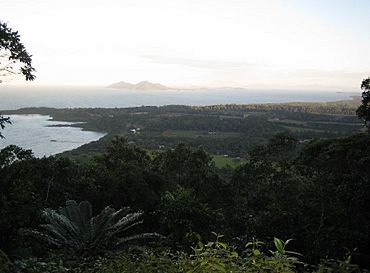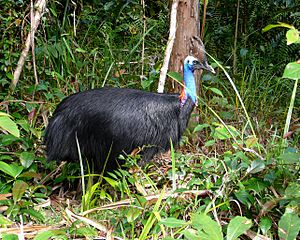Mission Beach, Queensland facts for kids
Quick facts for kids Mission BeachQueensland |
|||||||||||||||
|---|---|---|---|---|---|---|---|---|---|---|---|---|---|---|---|

Mission Beach
|
|||||||||||||||
| Population | 1,014 (2021 census) | ||||||||||||||
| • Density | 74.56/km2 (193.1/sq mi) | ||||||||||||||
| Established | 1914 | ||||||||||||||
| Postcode(s) | 4852 | ||||||||||||||
| Elevation | 10 m (33 ft) | ||||||||||||||
| Area | 13.6 km2 (5.3 sq mi) | ||||||||||||||
| Time zone | AEST (UTC+10:00) | ||||||||||||||
| Location |
|
||||||||||||||
| LGA(s) | Cassowary Coast Region | ||||||||||||||
| State electorate(s) | Hill | ||||||||||||||
| Federal Division(s) | Kennedy | ||||||||||||||
|
|||||||||||||||
Mission Beach is a beautiful coastal town in Queensland, Australia. It's part of the Cassowary Coast Region. In 2021, about 1,014 people lived here. It's known for its stunning beaches and rainforests, making it a popular spot for visitors.
Contents
Discovering Mission Beach's Geography
Mission Beach sits right next to the amazing Coral Sea on its eastern side. Just 4 kilometers (about 2.5 miles) offshore is Dunk Island, a popular place for tourists to visit.
What we call Mission Beach today used to be several smaller villages. These villages have grown and joined together over time. From south to north, they include South Mission Beach, Wongaling Beach, Mission Beach itself, Bingil Bay, Brooks Beach, and Carmoo. There's also new development happening at Garners Beach to the north.
A Look at Mission Beach's History
Early Settlers and Events
The first European settlers in the Mission Beach area were the Cutten brothers. They arrived in 1882 and made their home at Bingil Bay. Here, they started farms, growing fruits like mangoes, bananas, and pineapples. They also grew coffee and coconuts. They even made their own coffee! Their farm produce was sent south by cargo boats.
Before the Cutten brothers, the only other Europeans in the area were timber-getters. These workers sometimes camped on the beach to collect timber from the nearby rainforests. They often hired local Aboriginal people to help them move the timber. They paid them with things like tobacco and tools. Generally, the local Aboriginal people were friendly.
In 1872, a ship called the Maria was wrecked. Some survivors of the wreck had difficult encounters with certain groups of local people. This led to a period of conflict in the area. The river Louisa was later renamed Maria Creek because of this event. Johnstone River was named after Sub-Inspector Johnstone, who was involved in the events that followed the wreck.
After the Cutten brothers, other families also settled in the area. The Unsworths settled at Narragon Beach, the Garners at Garners Beach, and the Porter brothers near what is now called Porter's Creek (also known as Wongaling Creek).
The Hull River Settlement
In the early 1900s, Chinese banana farmers in the Tully River region employed Aboriginal people as workers. To manage issues that arose, the Queensland government decided to create a special settlement for Aboriginal people at what is now Mission Beach. This settlement began on September 1, 1914, led by Superintendent John Martin Kenny. It was not a religious mission but a place where Aboriginal people were settled.
However, a powerful cyclone hit on March 10, 1918. It destroyed the Hull River settlement and the superintendent's home. Sadly, Superintendent Kenny and his daughter died during the storm. The Aboriginal people who survived were later moved to Palm Island, Queensland.
Modern History
The Mission Beach Post Office officially opened its doors on December 15, 1949. In the 2006 census, Mission Beach had a population of 515 people. By 2016, the population had grown to 815 people. In the most recent 2021 census, the population of Mission Beach was 1,014 people.
Mission Beach's Economy
The Mission Beach area is not just about tourism. It also has a big farming industry. Farmers here grow a lot of sugar cane and bananas, which are important crops for the region.
Education in Mission Beach
There are no schools directly in Mission Beach town. The closest primary school is Mission Beach State School, located in Webb Road, Wongaling Beach. For high school students, the nearest government secondary school is Tully State High School, which is in Tully to the south-west.
Amenities and Community Life
Mission Beach has a Uniting Church located at 2224 Tully Mission Beach Road. It's part of the wider Cassowary Coast Uniting Church community.
If you like sports, the Mission Beach Barracudas football (soccer) club has teams that play in the local Johnstone River Football Association league.
Exciting Events in Mission Beach
Every September, Mission Beach hosts the annual Cassowary Festival. This festival celebrates the amazing wildlife of the region, especially the unique cassowary bird. It's a fun event with music, activities, and educational programs for the whole community. The town also used to have an aquatic festival, but it stopped in 2017.
Tourism and Natural Wonders
Mission Beach is a fantastic place for tourists! The beach is surrounded by green mountains that rise up close to the shore. From the beach, you can see beautiful views of the Family Islands National Park.
Close to the shore at Mission Beach, there's a shallow reef. When the tide is very low, parts of this reef can even be seen above the water. This reef stretches from Porter's Creek almost to Clump Point and is a popular spot for fishing.
Mission Beach is special because it's surrounded by World Heritage listed rainforest on one side and the World Heritage listed Great Barrier Reef on the other. This means it's home to many different kinds of wildlife. The most famous animal here is the cassowary. This large bird cannot fly and lives in the rainforests around the area. Even with some land clearing and traffic, these birds seem to be doing well. Much of the area is part of the Coastal Wet Tropics Important Bird Area, which means it's very important for protecting lowland tropical rainforest birds.
Mission Beach is also the main starting point on the mainland for trips to Dunk Island. Water taxis used to take day-trippers out to the island, though services may vary.



